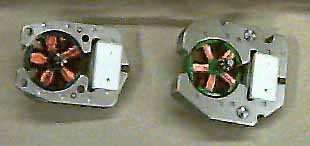
June 2000:
The diesel locomotive V188 (37282) makes some noise if the sound module is switched off. With light on the noise became louder. It is possible to reduce the output power at the track with Intellibox (Menu: Scale) and Control Unit (dip 4). With lower voltage the noise became softer.
April 2000:
There are some problems with the 60901 sets. I have bought 5 of them, and this locos, which I had rebuild with, were jerking after a few days and stopped for a while. The reason was a dirty commutator. The new coals are softer and/or the edges of the commutators are sharper. In any case the rifts between the commutators were full of coal dust. Because of this there was a short circuit in the rotor and the overload protection of the decoders was activated. Now I use older coals and had made the edges of the commutators smooth.
December 1999:
The locomotive BR 086 from the train set 26508 has a modified LFCM. Instead of a 3 pole disk collector rotor there is a 5 pole drum collector rotor inside the old motor block. The rotor has the same diameter as the one from the 60901-set, but the gear has 8 teeth instead of 7, stands out a bit further and has an axle with a larger diameter. The stator has many individual metal layers and also has a 7557 magnet. Due to this, the magnetic field extends further and the motor has more torque. The picture shows the two rotors with the stators in comparison. The motor shield is also a new version, only the brushes are the usual 60 14 60. As of April it should be possible to purchase these items, inclusive the 60902 decoder as part of the modification set for LCFMs. The decoder on the 086 is also a new development. This special version of 60901 (60 38 58) measures 22 x 16.5 mm and only has the standard function f0. It is ideally suited for locomotives with limited space.

October 1999:
After rebuilding some LFCM engines to c90, I noticed that some locos drives forward slower or faster than with the reverse movement. This difference is sometimes up to sensational 30%! Thus I dismantled all my LFCM locomotives and compared the rotors. Some differences at the commutators were noticeable to me. This are the three, circularly arranged copper plates, which has contact to the coal and copper brush. Locomotives, which do not indicate difference in the direction speed, the comutator sets accurately by 30 degrees to the coils. Locomotives with large rate difference indicate only one angle of 24-28 degrees. It is particularly bad with my rotor 225800 with 7 teeth, there are only 22 degrees! The rate difference was accordingly large. While driving forward to a rhythmic jerks came as if the regulation of the decoder goes crazy..
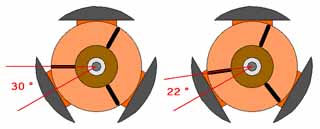
September 1999:
Analogues direct current drivers, who does the HAMO locomotives do not drive well enough, can tune it with the 60901-Set. If the stronger stator 389000 and the five-pin rotor 386820 including engine sign 386940 is used, the locomotives has a better slow handling. Also the locos has more power. Unfortunately thereby however also the locking moment of the engine rises, i.e. the discharge in dead areas is shorter.
July 1999:
Locomotives with 60901/2 have a clearly higher traction power than with the old 6090 decoder. That applies in particular to LFCM or Roco locos. All locomotives create it with drive position 1 with heavy course uphill to start. With the old 6090 decoder the potentiometer for the maximum speed has influence on the starting tractive power. If the potentiometer is turned to the left, the locos runs slower, nut it has also less power. The only disadvantage of the new decoder is the higher maximum speed. Old 6090 decoder functions unfortunately only with the DCM optimally.
May 1999:
The new decoder 60901/2 has 27 drive positions available, which can be selected only indirectly. With accelerating only the odd drive positions (1, 3, 5...) are used, while during braking only the even are used (... 4, 2, 0). Old decoders, like the 6090 uses only the even drive positions. The new, odd were intermediate drive positions. To bring a 60901/2 decoder to the correct (old) drive position 1, so that it drives just as fast as a locomotive with old 6090 decoder, it must transmit first the drive position 2, and then to drive position 1, otherwise it is only on drive position 0.5.
April 1999:
Locomotives with a LFCM and the HAMO stator 220560 gets a relatively good handling with the 60902 decoder, but during slow travel downhill (drive position 1) easy load change reactions are to observe (jerky). With the old 6090 decoder the handling is better. Driving uphill both decoder are equivalent. If the max. speed poti set to minimum, the loco runs smoother.
March 1999:
The decoder 60902 is unsuitable for a LFCM with the stator 220970 (magnets 506680). The engine draws so much current, which addresses the overload circuit of the decoder. With the HAMO stator 220560 the power input is lower. The handling is mosly like a 37xxx-Lok, only the sound is somewhat different.
January 1999:
The blue steam locomotive from the Premium start set has sometimes problems. The chassis lighting goes out while driving and can only be re-activated after an emergency stop. The failure is the circuit board with the four yellow LEDs. Maerklin mount one SMD capacitor too much. After unscrewing the LED circuit board, in the center is to see the brown capacitor between the two black diodes. That must away! Then everything functions correct. This eliminates also possible malfunctionings of the smoke generator with switched on the chassis light.
December 1998:
Connections of the 60960:
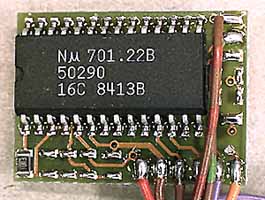
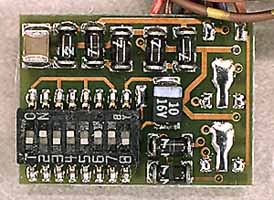
red = pickup shoe (power/data)
brown = ground (power)
orange = back conductors for all functions (positive DC)
brown/red = function f1 (negative DC)
brown/green = function f2 (negative DC)
brown/yellow = function f3 (negative DC)
brown/white = function f4 (negative DC)
purple = electronic ground (negative DC)
All function outputs are short circuit proofed.
Dezember 1998:
Connections of the 60901/60902:

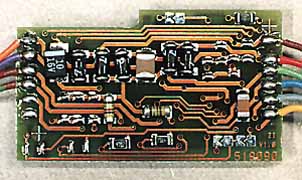
red = pickup shoe (power/data)
brown = ground (power)
blue = motor
green = motor
grey = front light function f0 (negative DC)
yellow = back light function f0 (negative DC)
orange = back conductors for all functions (positive DC)
brown/red = function f1 (negative DC)
brown/green = function f2 (negative DC)
brown/yellow = function f3 (negative DC)
brown/white = function f4 (negative DC)
purple = electronic ground (negative DC)
October 1998:
Locomotives with digital high-power engine of newer design have 3 capicators with a capacity of 1000 each pF (1 nF) to serve primarily of the noise suppression. Locomotives with catalog number of five figures e.g. 37xxx may have now the CE sign.
October 1998:
Locomotives with the new high-power engine 60901 have now three choke coils with 3.9 uH. Two were used at the motor shield, third between pickup shoe and decoder. These choke coils protect the decoder against voltage peaks.
October 1998:
The first locomotives with 60901 (e.g. V200/Sound 37803) were delivered with the chip 701.17b. The decoder has usually a big Elko with 2,2 UF on the circuit board. For problems (whistle goes arbitrarily loosely or suddenly in false sound height) the whole decoder in the factory was exchanged. The new decoder has a 701.22 like in the Adenauer 01 (37102) or in the 52Kon (37171).